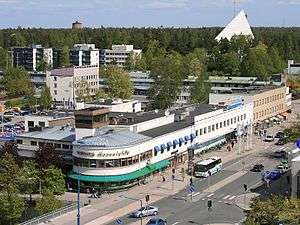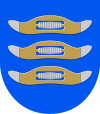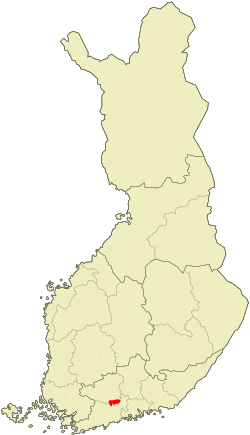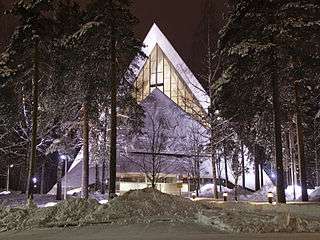Hyvinkää
Hyvinkää (Finnish pronunciation: [ˈhyʋiŋkæː]; Swedish: Hyvinge [ˈhʏ̂vːɪŋɛ], Finland Swedish: [ˈhyviŋe]) is a town and municipality of Finland. It is located in the Uusimaa region, approximately 50 kilometres (30 mi) north of the capital Helsinki. The town was chartered in 1960. Hyvinkää belongs to the region of Uusimaa. The population of Hyvinkää is 46,537 (31 January 2019).[2]
Hyvinkää Hyvinge | |
|---|---|
Municipality and town | |
| Hyvinkään kaupunki Hyvinge stad | |
 Ahjo building from 1935 in central Hyvinkää. The church of Hyvinkää in the background. | |
 Coat of arms | |
 Location of Hyvinkää in Finland | |
| Coordinates: 60°38′N 024°51′E | |
| Country | |
| Region | Uusimaa |
| Sub-region | Helsinki sub-region |
| Charter | 1917 |
| City rights | 1960 |
| Government | |
| • Town manager | Jyrki Mattila |
| Area (2018-01-01)[1] | |
| • Total | 336.77 km2 (130.03 sq mi) |
| • Land | 322.62 km2 (124.56 sq mi) |
| • Water | 14.14 km2 (5.46 sq mi) |
| Area rank | 229th largest in Finland |
| Population (2019-01-31)[2] | |
| • Total | 46,537 |
| • Rank | 24th largest in Finland |
| • Density | 144.25/km2 (373.6/sq mi) |
| Population by native language | |
| • Finnish | 95.9% (official) |
| • Swedish | 0.8% |
| • Others | 3.4% |
| Population by age | |
| • 0 to 14 | 17.8% |
| • 15 to 64 | 66.9% |
| • 65 or older | 15.3% |
| Time zone | UTC+02:00 (EET) |
| • Summer (DST) | UTC+03:00 (EEST) |
| Municipal tax rate[5] | 19.25% |
| Climate | Dfc |
| Website | www |
Highways and rail connections make it one of the suburban commuter centers of Greater Helsinki. The city planning has had an emphasis on recreational facilities.
Some of the more well-known buildings in Hyvinkää are, among others, the Church (1961, Aarno Ruusuvuori) of Hyvinkää and the manor house of Kytäjä. The Finnish Railway Museum is located in Hyvinkää.
Hyvinkää is also home to Konecranes, which specializes in the manufacture and service of cranes, and KONE Elevators, the world's third-largest elevator company who manufacture, install and service elevators and escalators.
The workshop of Ruokangas Guitars, the leading Finnish electric guitar maker, was located at Wanha Villatehdas, Hyvinkää until 2011.
Hyvinkää is known among Scandinavian golf enthusiasts due to Kytäjä golf, located at the countryside of Hyvinkää. It offers two courses designed by Tom McBroom: South East Course opened in August 2003, and North West Course in August 2004.
History

In the 16th century there was a tavern in the area now known as Hyvinkäänkylä, which lies approximately halfway between Helsinki and Hämeenlinna. The first tax catalogues also marked the existence of some houses in the area around the same time.
Hyvinkää village gradually grew in the latter half of the 19th century, though it was the construction of the railway network through Finland, beginning in 1861, that marked the starting point for the town's rapid growth. Hyvinkää, who still belonged to the Nurmijärvi parish at that time, resigned in 1917 as its own parishioner.[6]
The construction of Finland's first stretch of railroad, the Helsinki–Hämeenlinna line, determined the location of the present city centre and the railway station of Hyvinkää is one of the few original stations still in use. From Hyvinkää the railway also branches off to the port of Hanko. The Hanko–Hyvinkää Railroad was the first private railroad in Finland, founded in 1862, and acquired by the Finnish State RR Co. in 1875. In the early 20th century, the station village in Hyvinkää was an intermediate stopping point for many emigrants leaving by ship from Hanko for a new life in North America.
The air quality of Hyvinkää was considered healthy due to dense pine forests, and in the 1880s a group of physicians from Helsinki opened a sanatorium for patients seeking rest and recuperation.
Industrialization brought a wool factory to Hyvinkää in 1892 – the Donner family's Hyvinge Yllespinneri. The factory ceased operation in the 1990s, but the red-brick halls still remain. The building has found several new uses, including an exhibition centre and a theater.
Hyvinkää Airfield served as the country's main airport for a short time after the second World War while Helsinki-Malmi Airport was under the control of the Allied Powers. There is now a motorsports centre near the airfield.
Hyvinkää's population grew quickly following the Second World War. It became home to many Finnish Karelian refugees after Karelia was handed out to Soviet Union by the Moscow Peace Treaty. Nowadays Hyvinkää is the sixth biggest town by inhabitants of Uusimaa.
Politics
Results of the 2011 Finnish parliamentary election in Hyvinkää:
- National Coalition Party 25.1%
- Social Democratic Party 23.9%
- True Finns 22.4%
- Green League 8.1%
- Left Alliance 7.6%
- Centre Party 7.5%
- Christian Democrats 2.9%
- Swedish People's Party 0.8%
Notable residents of Hyvinkää
- Heikki Mikkola, 4 Times World Champion, Motocross
- Katri Rosendahl, Endurance Riding National Champion [2007]
- Juha Ruokangas, master luthier, founder of Ruokangas Guitars
- Yrjö Saarinen, painter
- Tyko Sallinen, painter
- Helene Schjerfbeck, painter
- Jalmari Ruokokoski, painter
- Ossi Savolainen, mayor of Hyvinkää
- Esa Saarinen, philosopher
- Lauri Tukonen, professional ice hockey player
- Markku Uusipaavalniemi, curler, politician
- Petteri Wirtanen, professional ice hockey player
- Roni Tran Binh Trong, singer
- Peetu Piiroinen, Olympic Silver Medallist in the Men's Halfpipe
- Sanna Valkonen, professional football player
- Sauli Koskinen, TV presenter living in Los Angeles
- Aki Klemm, Musician, Composer, Artist
- Jaan Markus Keski-Kastari, California Champion Wake Boarder/ MX-3 racer/ Olympic Candidate Snowboarder
Public services
Health care
There are three health care centers in Hyvinkää. Hyvinkää hospital is one of largest general hospitals in Finland. The emergency unit services 24 hours in day.
Education
There are twenty primary schools in Hyvinkää: Anttila school (grades 1–2), Asema school (and the English classes of Hyvinkää), Hakala school, Hyvinkäänkylä school, Hämeenkatu school, Härkävehmas school (grades 3–9), Kaukas school, Kytäjä school, Martti school, Noppo school, Paavola school, Pohjoispuisto school (grades 7–9), Puolimatka school (grades 1–9), Ridasjärvi school, Svenska skolan i Hyvinge (Grades 1–6), Talvisilta school (Grades 1–2), Tapainlinna school (Grades 1–9), Uusikylä school and Vehkoja school (grades 3–9).
There are two high schools in Hyvinkää; Hyvinkään yhteiskoulun lukio and Sveitsin lukio.
Transportation
Railway

Hyvinkää is an important railway city, located on the primary rail route in southern Finland. Station building is one of the original Helsinki-Hämeenlinna railway stations in original use. The city is also home to the Finnish Railway Museum and a VR maintenance area. Hyvinkää also has another railway line, the Hyvinkää-Karis railway towards Hanko (founded on 8 October 1873). Passenger traffic between Hyvinkää and Karis ended in September 1983, but the railway is still in use by VR Cargo.
Airfield
Hyvinkää airfield was the main airport of Finland in 1944–1947, when Helsinki-Malmi Airport was in use by the Allied Commission. Finnair used Hyvinkää as a major hub. Finnair's DC-3-pilots trained to fly at Hyvinkää airfield in 1948.
Jukolan Pilotit, Mäntsälän Ilmailukerho and Hyvinkään ilmailukerho operate from the airfield.
Buses
The Local bus service is operated by Hyvinkään Liikenne. There are six local bus lines.
Sports
Hyvinkää has a large variety of sports. Hyvinkään Tahko plays pesäpallo at men's top league, Superpesis. Hyvinkää Falcons plays american football in nation's second level in both men's and women's league system. Hyvinkään Palloseura or HyPS plays association football in the fourth division in men's and in the fifth division in women's football. Hyvinkää has three men's ice hockey teams of which Hoki Klupi Hyvinkää plays in the fourth division and Hyvinkää Bruins and Hyvinkää Storm in the fifth division. In basketball Hyvinkään Ponteva plays in men's first division and in women's top league.
Festivals

In the Summer, there is an annual beer festival which attracts rock bands from Scandinavia and about 10,000 visitors.
International relations
Twin towns – Sister cities
Hyvinkää is twinned with:[7]
Projects
The educational department takes part in Lifelong Learning Programme 2007–2013 in Finland.
See also
References
- "Area of Finnish Municipalities 1.1.2018" (PDF). National Land Survey of Finland. Retrieved 30 January 2018.
- "Suomen virallinen tilasto (SVT): Väestön ennakkotilasto [verkkojulkaisu]. Tammikuu 2019" (in Finnish). Statistics Finland. Retrieved 15 March 2019.
- "Population according to language and the number of foreigners and land area km2 by area as of 31 December 2008". Statistics Finland's PX-Web databases. Statistics Finland. Retrieved 29 March 2009.
- "Population according to age and gender by area as of 31 December 2008". Statistics Finland's PX-Web databases. Statistics Finland. Retrieved 28 April 2009.
- "List of municipal and parish tax rates in 2011". Tax Administration of Finland. 29 November 2010. Retrieved 13 March 2011.
- Korjus, Olli (2014). Kuusi kuolemaantuomittua. Atena Kustannus Oy. ISBN 978-952-30002-4-7.
- "Ystävyyskaupungit" (in Finnish). City of Hyvinkää. 7 August 2019. Retrieved 23 August 2019.
External links
| Wikimedia Commons has media related to Hyvinkää. |
| Wikivoyage has a travel guide for Hyvinkää. |
